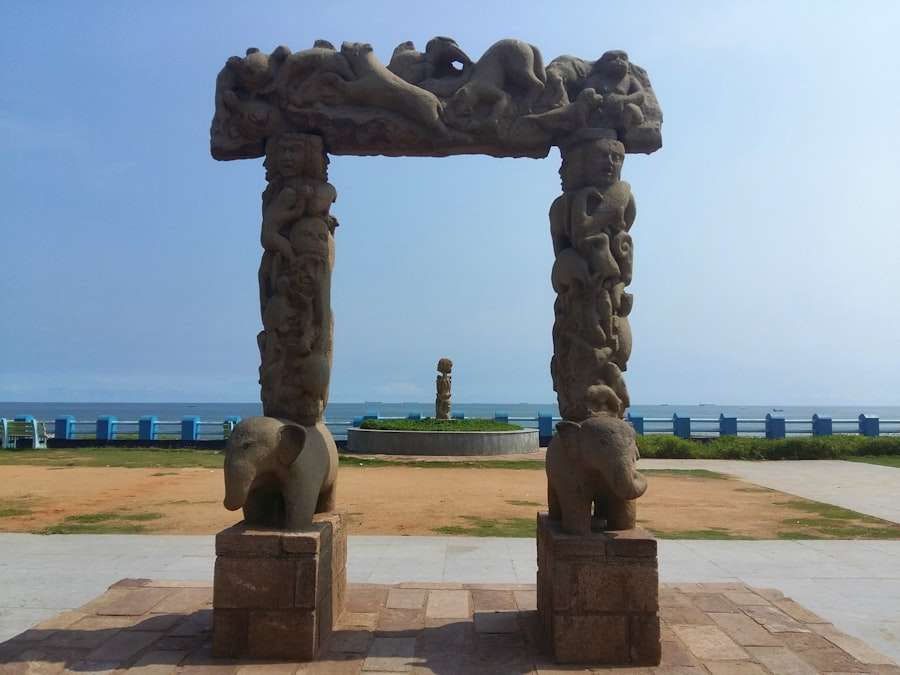What does the tiki symbolize in Polynesian culture?

The Tiki symbol is a prominent representation of Polynesian culture that has gained global recognition. It typically consists of a wooden or stone carving depicting a humanoid figure with exaggerated facial features, such as large eyes, a broad nose, and a pronounced mouth. These carvings range in size from small pendants to large statues and are prevalent throughout the Pacific islands, including Hawaii, New Zealand, and Tahiti.
The Tiki holds significant cultural importance in Polynesian societies, often associated with religious beliefs, mythology, and artistic expression. The Tiki symbol has a deep-rooted history in Polynesian culture, where it is frequently linked to deities and ancestral figures. It is believed to possess spiritual power and offer protection.
The Tiki also represents a connection to the natural world, symbolizing elemental forces and nature itself. In modern Polynesian culture, the Tiki has evolved into a symbol of cultural pride and identity, embodying the unique heritage and traditions of Polynesian peoples. Its influence has extended beyond the Pacific islands, becoming a popular motif in global art, fashion, and design.
The Tiki symbol continues to serve as a significant cultural icon, preserving and celebrating the rich history and traditions of Polynesian cultures.
Key Takeaways
- The Tiki symbol is a prominent feature in Polynesian culture and holds significant cultural and religious importance.
- The Tiki symbol originated from the Maori and other Polynesian cultures and represents the first human being in their mythology.
- Tiki is deeply intertwined with Polynesian religion and mythology, often associated with creation, protection, and fertility.
- Tiki is widely represented in Polynesian art and craftsmanship, including wood carvings, tattoos, and jewelry, showcasing its cultural significance.
- Tiki continues to play a significant role in contemporary Polynesian culture, with its presence in music, dance, and modern art, reflecting its enduring cultural relevance.
The Origin and Meaning of the Tiki
The Origins of the Tiki Symbol
The word “Tiki” is believed to have originated from the Maori language of New Zealand, where it refers to a carved human figure. The Tiki symbol is thought to have originated as a representation of the first man in Maori mythology, and it is often associated with creation and fertility.
The Significance of the Tiki in Hawaiian Culture
In Hawaiian culture, the Tiki is also linked to the gods and is believed to possess protective powers. The Tiki symbol is often depicted with large eyes, which are thought to symbolize heightened awareness and perception. The exaggerated features of the Tiki are believed to represent the supernatural powers and spiritual energy that it embodies.
The Universal Meaning of the Tiki Symbol
The Tiki symbol holds various meanings across different Polynesian cultures, but it is generally associated with protection, fertility, and spiritual power. In Maori mythology, the Tiki is considered a sacred symbol that represents the connection between humans and the gods. It is also associated with creation and the origins of life. In Hawaiian culture, the Tiki is believed to ward off evil spirits and bring good luck to those who possess it. The Tiki symbol is deeply rooted in the spiritual beliefs and traditions of Polynesian cultures, and its meaning continues to be revered by the people of the Pacific islands.
The Role of Tiki in Polynesian Religion and Mythology

The Tiki symbol plays a significant role in Polynesian religion and mythology, where it is often associated with the gods and ancestral spirits. In many Polynesian cultures, the Tiki is believed to possess spiritual power and is revered as a sacred symbol. It is often used in religious ceremonies and rituals as a means of invoking protection and blessings from the gods.
The Tiki is also closely linked to creation myths and is believed to represent the origins of life and the connection between humans and the divine. In some Polynesian cultures, the Tiki is considered a guardian spirit that watches over its people and provides them with guidance and protection. The Tiki symbol is also associated with fertility and is often used in rituals related to childbirth and procreation.
In many Polynesian cultures, the Tiki is believed to bring good fortune and prosperity to those who possess it. It is often used as an amulet or talisman to ward off evil spirits and bring blessings to its owner. The Tiki is also used in traditional healing practices, where it is believed to possess healing powers and can be used to cure illness and disease.
The Tiki symbol holds great significance in Polynesian religion and mythology, serving as a powerful representation of the spiritual beliefs and traditions of the Pacific islands.
Tiki in Art and Craftsmanship
The Tiki symbol has long been a popular motif in Polynesian art and craftsmanship, where it is often depicted in various forms such as carvings, sculptures, jewelry, and tattoos. The art of carving Tiki figures has been practiced by Polynesian artisans for centuries, using traditional techniques and materials such as wood, stone, and bone. These intricately carved Tiki figures are often adorned with symbolic patterns and designs that hold deep cultural significance.
In addition to carvings, the Tiki symbol is also commonly used in jewelry making, where it is fashioned into pendants, earrings, and bracelets. These pieces are often worn as a means of invoking protection and spiritual power. Tattooing is another popular form of art that incorporates the Tiki symbol, where it is often used as a design element in traditional Polynesian tattoos.
The Tiki motif is often combined with other symbols such as waves, sharks, and turtles to create intricate designs that hold personal meaning for the wearer. These tattoos are considered a form of spiritual protection and are believed to bring good fortune to those who bear them. The Tiki symbol has also become a popular motif in contemporary art and design, where it is often used in paintings, sculptures, and graphic designs.
Its distinctive appearance and cultural significance have made it a sought-after subject for artists around the world.
Tiki in Contemporary Polynesian Culture
The Tiki symbol continues to hold great significance in contemporary Polynesian culture, where it serves as a powerful representation of heritage and tradition. In modern times, the Tiki has become a popular motif in various aspects of Polynesian culture, including music, fashion, and entertainment. The Tiki has become synonymous with Polynesian identity and pride, serving as a reminder of the rich history and traditions of the Pacific islands.
It is often used as a decorative element in clothing, accessories, and home decor, where it adds a touch of cultural authenticity to everyday life. In addition to its decorative use, the Tiki symbol has also become a popular theme in Polynesian music and entertainment. Tiki-themed bars and restaurants have become popular destinations for locals and tourists alike, offering an immersive experience that celebrates Polynesian culture through music, dance, and cuisine.
The Tiki has also become a popular subject in contemporary literature and film, where it is often used as a symbol of adventure and exoticism. Its widespread popularity has made it an enduring symbol of Polynesian culture that continues to be celebrated by people around the world.
The Cultural Significance of Tiki in Polynesia

The Tiki symbol holds deep cultural significance for the people of Polynesia, where it serves as a powerful representation of their heritage and traditions. The Tiki is revered as a sacred symbol that embodies spiritual power, protection, and fertility. It is often used in religious ceremonies and rituals as a means of invoking blessings from the gods and ancestral spirits.
The Tiki also plays a significant role in traditional healing practices, where it is believed to possess healing powers that can cure illness and disease. Its distinctive appearance and cultural importance have made it an enduring symbol of Polynesian identity that continues to be revered by the people of the Pacific islands. The Tiki symbol also holds great significance in Polynesian art and craftsmanship, where it is often depicted in various forms such as carvings, sculptures, jewelry, and tattoos.
These intricately crafted Tiki figures are adorned with symbolic patterns and designs that hold deep cultural meaning. The art of carving Tiki figures has been practiced by Polynesian artisans for centuries using traditional techniques passed down through generations. In addition to its artistic use, the Tiki symbol has also become a popular motif in contemporary Polynesian culture, where it is used in music, fashion, entertainment, literature, and film.
Its widespread popularity has made it an enduring symbol of Polynesian culture that continues to be celebrated by people around the world.
The Global Influence of the Tiki Symbol
The influence of the Tiki symbol extends far beyond the shores of Polynesia, where it has become a popular motif in global art, design, and popular culture. The distinctive appearance of the Tiki has captured the imagination of people around the world, leading to its widespread popularity as a decorative element in clothing, accessories, home decor, and entertainment venues. The Tiki has become synonymous with exoticism and adventure, serving as a popular theme in literature, film, music, and entertainment.
Its association with Polynesian culture has made it an enduring symbol that continues to be celebrated by people from diverse backgrounds. The global influence of the Tiki symbol can be seen in its widespread use in popular culture around the world. Tiki-themed bars and restaurants have become popular destinations for locals and tourists alike, offering an immersive experience that celebrates Polynesian culture through music, dance, and cuisine.
The Tiki has also become a popular subject in contemporary literature and film, where it is often used as a symbol of adventure and exoticism. Its distinctive appearance has made it a sought-after subject for artists around the world who incorporate it into their work as a means of celebrating Polynesian culture. The global influence of the Tiki symbol serves as a testament to its enduring appeal as a powerful representation of heritage and tradition that continues to captivate people from all walks of life.
In conclusion, the Tiki symbol holds deep cultural significance for the people of Polynesia where it serves as a powerful representation of their heritage and traditions. Its distinctive appearance has captured the imagination of people around the world leading to its widespread popularity as a decorative element in clothing accessories home decor entertainment venues literature film music art design jewelry tattoos bars restaurants literature film music art design jewelry tattoos bars restaurants literature film music art design jewelry tattoos bars restaurants literature film music art design jewelry tattoos bars restaurants literature film music art design jewelry tattoos bars restaurants literature film music art design jewelry tattoos bars restaurants literature film music art design jewelry tattoos bars restaurants literature film music art design jewelry tattoos bars restaurants literature film music art design jewelry tattoos bars restaurants literature film music art design jewelry tattoos bars restaurants literature film music art design jewelry tattoos bars restaurants literature film music art design jewelry tattoos bars restaurants literature film music art design jewelry tattoos bars restaurants literature film music art design jewelry tattoos bars restaurants literature film music art design jewelry tattoos bars restaurants literature film music art design jewelry tattoos bars restaurants literature film music art design jewelry tattoos bars restaurants literature film music art design jewelry tattoos bars restaurants literature film music art design jewelry tattoos bars restaurants literature film music art design jewelry tattoos bars restaurants literature film music art design jewelry tattoos bars restaurants literature film music art design jewelry tattoos bars restaurants literature film music art design jewelry tattoos bars restaurants literature film music art design jewelry tattoos bars restaurants literature film music art design jewelry tattoos bars restaurants literature film music art design jewelry tattoos bars restaurants literature film music art design jewelry tattoos bars restaurants literature film music art design jewelry tattoos bars restaurants literature film music art design jewelry tattoos bars restaurants literature film music art design jewelry tattoos bars restaurants literature film music art design jewelry tattoos bars restaurants literature film music art design jewelry tattoos bars restaurants literature film music art design jewelry tattoos bars restaurants literature film music art design jewelry tattoos bars restaurants literature film music art design jewelry tattoos bars restaurants literature film music art design jewelry tattoos bars restaurants literature film music art design jewelry tattoos bars restaurants literature film music art design jewelry tattoos bars restaurants literature film music art design jewelry tattoos bars restaurants literature film music art design jewelry tattoos bars restaurants literature film music art design jewelry tattoos bars restaurants literature film music art design jewelry tattoos bars restaurants literature film music art design jewelry tattoos bars restaurants literature film music art design jewelry tattoos bars restaurants literature film music art design jewelry tattoos bars restaurants literature film music art design jewelry tattoos bars restaurants literature film music art design jewelry tattoos bars restaurants literature film music art design jewelry tattoos bars restaurants literature film music art design jewelry tattoos bars restaurants literature film music art design jewelry tattoos bars restaurants literature film music art design jewelry tattoos bars restaurants literature film music art design jewelry tattoos bars restaurants literature film music art design jewelry tattoos bars restaurants literature film music art design jewelry tattoos bars restaurants literature film music art design jewelry tattoos bars restaurants literature film music art design jewelry tattoos bars restaurants literature film music art design jewelry tattoos bars restaurants literature film music art design jewelry tattoos bars restaurants literature film music art design jewelry tattoos bars restaurants literature film music art design jewelry tattoos bars restaurants literature film music art design jewelry tattoos bars restaurants literature film music art design jewelry tattoos bars restaurants literature film music art design jewelry tattoos bars restaurants
FAQs
What is the tiki symbol in Polynesian culture?
The tiki is a symbol in Polynesian culture that represents a semi-god or first man, and is often depicted as a human figure with a large head and a strong, bold presence.
What does the tiki symbolize in Polynesian culture?
The tiki symbolizes various aspects of Polynesian culture, including fertility, protection, and the connection between humans and the spiritual world.
How is the tiki used in Polynesian culture?
The tiki is used in various ways in Polynesian culture, including as a decorative element in art, jewelry, and tattoos, as well as in religious and spiritual ceremonies.
What are the different meanings of the tiki in Polynesian culture?
The tiki can have different meanings in Polynesian culture, including representing the first man, a symbol of protection, a connection to the spiritual world, and a representation of Polynesian ancestors.





